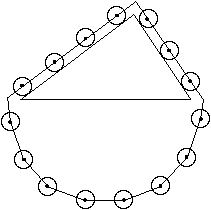
Simon Stevin(1548-1620) was a Dutch engineer. He was a contemporary of Galileï (1564-1642). Unlike the latter he had no time for public relations: he was too busy in constructing fortresses, bridges, etc. in our war of liberation against Spain. So he couldn't organize a lawsuit against himself in the way Galileï did; of course, the liberal climate in our country (I mean the religious and social climate; the meteorological climate was less liberal: according to our history books the main reason that we could throw the Spaniards out seems to be the cold and wet weather) didn't help him much to get such a lawsuit. As a consequence, Stevin became much less famous than Galileï, though he did many of the things which Galileï did, often better, and most of the times earlier (yes, I am not an Italian:-).
He was not only theoretically envolved with the scientific problems
of his time, but also practically. He was the mathematics and
mechanics teacher of Prince Maurits and he was an expert in the art
of fortification (those who know our local history can learn from
this why Prince Maurits could be so successful in fighting the Spanish
armies), he developed the teaching program of a new school for
enginieers in Leiden, he worked on an improved concept for mills, he
wrote about the art of navigation, etc.. For short: he knew about
everything which made our nation great in that time (and attractive
for tourists now).
He argued that to make science useful it was not only necessary that
all publications were written in the native language (therefore, he
used Dutch words for all scientific and mathematical terms known
to him (some of which he coined himself, but perhaps not as many as was sometimes believed --- see this page, in Dutch) --- most of which are still in use), but that it should also be simplified as much as possible. For instance, he was an ardent
advocate of the use of decimal fractions and of the decimal system
for coins, measures and weights.
But he also did purely scientific experiments, were he found
(like Galileï) that the time needed for a falling body to reach
the bottom is independent of the weight of that body.
As I suggested above, he could promote the Copernican vision without
repercussions from the Inquisition.
One of his most famous reasonings, of which he was quite proud
himself, was the proof that in an equilibrium situation on an
inclined plane the weights of the bodies involved are proportional
with the lengths of the planes. Nowadays we prove that using the
sines of the angles that the planes make with the horizontal plane,
and we decompose the weights of the bodies in forces parallel and
perpendicular to the inclined planes. Stevin used an ingenious
geometrical argument. He considered the following picture:

His argument was that everything should be in equilibrium, for
otherwise one should have an 'eeuwig roersel' ['eeuwig' = eternal,
'roersel' = something that moves], i.e., a 'perpetuum mobile'.
Now leave out the 'free' balls hanging in the air (the system then
remains in equilibrium) and count the balls
on the inclining planes, and you have the above law!
In a similar vain he proved the Archimedian Law (which he called
'waterweegkundige wonderspreuk'; it's sad to relate that this phrase
didn't make it in our language!) by reducing it to the impossibility
of an 'eeuwig roersel'.